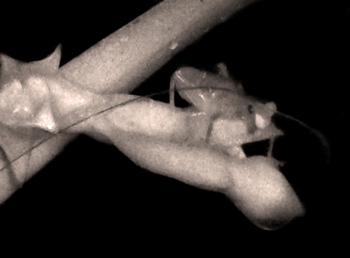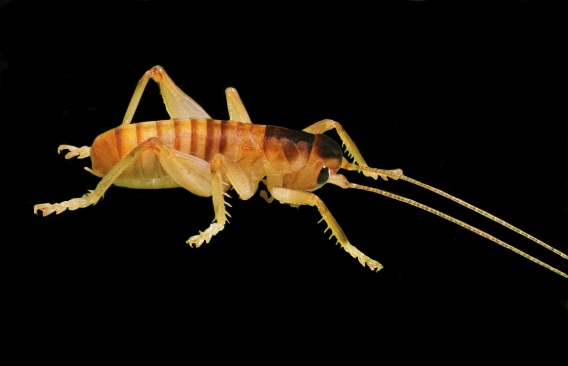East of Madagascar, on the small island of Reunion, researchers have made a remarkable discovery: a cricket that pollinates an orchid. The cricket, which is also a species new to science, was caught by a motion sensitive camera pollinating the orchid, Angraecum cadetii. The genus Angraecum orchid is usually pollinated by moths, but cadetti‘s nectar-spur opening is just the right shape for the cricket, known as the ‘raspy cricket’.
“We knew from monitoring pollen content in the flowers that pollination was taking place. However, we did not observe it during the day. That’s why we rigged up a night camera and caught this raspy cricket in action,” explains Claire Micheneau A PhD student working on epiphytic orchids, who published the findings in the Annals of Botany. In her research, Micheneau is collaborating with the Royal Botanic Gardens, Kew.
 The raspy cricket (Glomeremus sp) carrying pollen on its head. Photo by: Michenau and Fournel. |
“Watching the footage for the first time, and realizing that we had filmed a truly surprising shift in the pollination of Angraecum, a genus that is mainly specialized for moth pollination, was thrilling.”
Crickets are usually known for eating plants, not pollinating them. But the raspy cricket is unique: wingless, its reaches the flower by climbing the orchid’s leaves or jumping from adjacent plants. Not only is this the first known cricket to pollinate a plant, but Micheneau says that the cricket has proven quite an effective ally for the orchid.
“My studies have shown that the raspy cricket is also a surprisingly efficient pollinator with higher rates of pollination and fruit set in Angraecum cadetii than those recorded in its bird-pollinated sister-species,” Miccheneau says, adding that “we think the raspy cricket has evolved to eat nectar to compensate for the general scarcity of other insects on Reunion.”

The raspy cricket (Glomeremus sp). Photo by: Michenau and Fournel.

Angraecum cadetii is pollinated by the raspy cricket. Photo by: Michenau and Fournel.
Related articles
New species everywhere in Papua New Guinea’s ‘lost’ volcano

(09/07/2009) A five week expedition into a remote extinct volcano has uncovered a treasure trove of new species in Papua New Guinea, including what may be the world’s largest rat, a fanged frog, and a grunting fish. In all the expedition estimates it may have found around forty species unknown to science. The expedition was undertaken by a BBC film crew and scientists in January. Local trackers led them into the unexplored jungle, hidden beneath the Bosavi volcano’s 2,800 meter summit. Six months prior to arrival, fields of spinach and sweet potato were planted to feed the expedition in such a remote area.
Moths defend against bats by ‘jamming’ sonar
(07/16/2009) Researchers have discovered a species of tiger moth that eludes bats by jamming their echolocation with ultrasonic clicks, a discovery that adds to the list of defensive mechanisms that insects use to defend themselves against bats. The study is published in the journal Science.
Dragonflies migrate 14,000-18,000 km from India to S. Africa
(07/16/2009) Millions of dragonflies migrate thousands of kilometers across the Indian Ocean from southern India to Africa, reports the BBC.